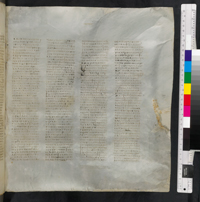Digitisation
One of the core undertakings of the project was to capture each page of Codex Sinaiticus as a high-quality digital image. Each image offers a substitute for the real manuscript leaf. Careful imaging of Codex Sinaiticus therefore provides a life-like view of the pages and allows, for the first time, worldwide access to the manuscript.
The digital photography of Codex Sinaiticus had to establish the best practice, taking into account that
- the leaves could not travel and had to be photographed at four different venues with different equipment;
- the writing on the leaves had to be readable on the digital images;
- the natural appearance of the parchment and ink had to be faithfully reproduced.
Technical standards
To make sure that the images produced were consistent, common standards and imaging practices were established across all venues by the Technical Standards Working Party. The recommendations included equipment (cameras, camera software, lighting, lenses, etc.) and processes (setup, colour profiling, etc.).
Lighting
When choosing the best lighting conditions for digitising Codex Sinaiticus, two aspects had to be carefully balanced. The writing on the leaves had to be readable on the digital images, to allow researchers to read and analyse it. At the same time, the natural appearance of the parchment and ink had to be faithfully reproduced, to allow the appreciation of the physical traits of Codex Sinaiticus.
Different angles and levels of intensity were tested for the lighting, as the same set-up had to be used for every page. Since each page reflected the light at different angles, owing to the natural undulation of the parchment, a compromise had to be found to minimise this effect. Best results were achieved when the pages were lit at an angle of 45 degrees on low intensity without any backlighting.
The parchment leaves of Codex Sinaiticus feature many marks on its surface - pricking holes, ruling indentations, as well as many other natural details - which are not easily visible with the 45 degree lighting directed from both sides of the page. The decision was therefore made to digitise each page twice, the second time with a light source at a low angle from a top corner. These are the 'raking light' images which optimise the view of the physical features of the parchment.
Background
The leaves of Codex Sinaiticus are so thin that the text from the other side of the page can show through when photographed. An appropriate background had to be used to lessen the show-through and at the same time to keep as true as possible to the colour of the parchment.
Tests showed that white background paper allowed a relatively faithful representation of the parchment colour. The text, however, was often very hard to read because of the show-through from the text on the other side of the leaf. Black background paper, on the other hand, reduced the show-through considerably in tests and made the text more readable. The page, however, appeared too dark and the colours were not represented faithfully.
 |
 |
| Test image of a Codex Sinaiticus page on a white background. |
Test image of a Codex Sinaiticus page on a black background. |
Through testing, the decision was made to opt for a compromise colour. A light brown background was chosen that was close enough to the colour of the parchment to give a sense of its warmth, while reducing the show-through to a point where it rarely makes reading the page difficult.
See a list of the digitisation experts in the Codex Sinaiticus Project.